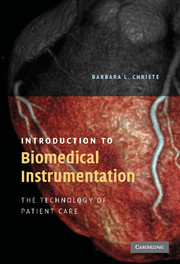Book contents
- Frontmatter
- Contents
- Preface
- INTRODUCTION TO BIOMEDICAL INSTRUMENTATION
- 1 BMET as a career
- 2 Patient safety
- 3 In the workplace
- 4 Electrodes, sensors, signals, and noise
- 5 The heart
- 6 Cardiac assist devices
- 7 Blood pressure
- 8 Respiration and respiratory therapy
- 9 The brain and its activity
- 10 The intensive care unit
- 11 The operating room
- 12 Imaging
- 13 Clinical laboratory equipment
- 14 Intravenous pumps and other pumps
- 15 Miscellaneous devices and topics
- Index
15 - Miscellaneous devices and topics
- Frontmatter
- Contents
- Preface
- INTRODUCTION TO BIOMEDICAL INSTRUMENTATION
- 1 BMET as a career
- 2 Patient safety
- 3 In the workplace
- 4 Electrodes, sensors, signals, and noise
- 5 The heart
- 6 Cardiac assist devices
- 7 Blood pressure
- 8 Respiration and respiratory therapy
- 9 The brain and its activity
- 10 The intensive care unit
- 11 The operating room
- 12 Imaging
- 13 Clinical laboratory equipment
- 14 Intravenous pumps and other pumps
- 15 Miscellaneous devices and topics
- Index
Summary
LEARNING OBJECTIVES
1 describe the role of BMETs in play therapy
2 define and describe fetal monitoring
3 define and describe nurse call systems
4 define and describe infant tracking systems
5 describe the role of BMETs in rehabilitation efforts
6 describe the role of BMETs in long-term patient care
Introduction
Many facets of the hospital culture engage technology as part of patient care, but they do not fit neatly into the traditional categories discussed so far. Children use technology (game consoles, for example) in play therapy. Women in labor are monitored using specific equipment. In addition, therapists and specialists, such as those involved in physical therapy and occupational therapy, also use technology. This chapter briefly examines patients who have long-term support needs.
Play therapy
Children's toys have increased in technological complexity over time. The role of play in a patient's recovery is well documented, and BMETs support this endeavor. BMETs ensure the devices are safe to use in the clinical setting, are secure from theft, can be cleaned appropriately, and are repaired when needed. In addition, some devices need adaptation to suit the needs of a particular patient. BMETs employed in children's hospitals face these challenges, which may call for creativity and sensitivity.
Fetal monitoring
Fetal monitors usually track uterine contractions and fetal heart rate simultaneously, often printing the information on long strips of paper. The medical team uses the two pieces of information together to evaluate fetal health and labor progress. A fetal monitor is shown in Figure 15.1.
- Type
- Chapter
- Information
- Introduction to Biomedical InstrumentationThe Technology of Patient Care, pp. 213 - 222Publisher: Cambridge University PressPrint publication year: 2009



